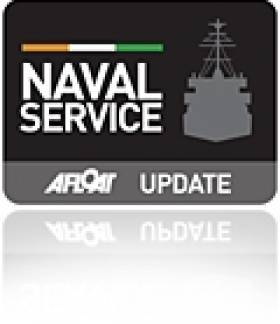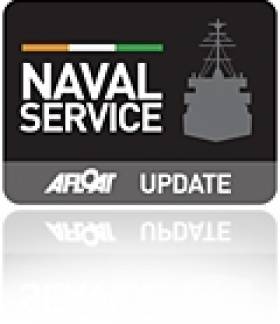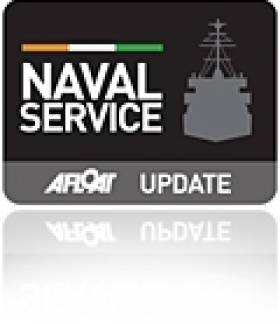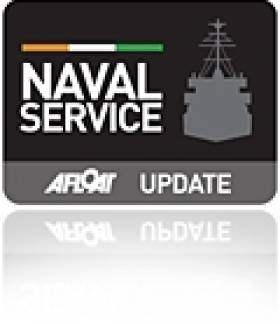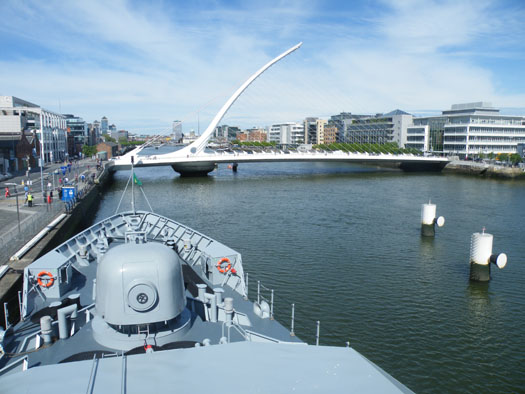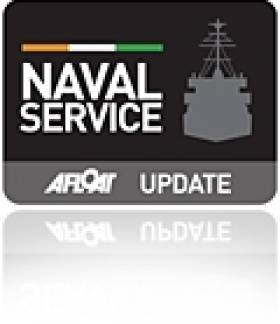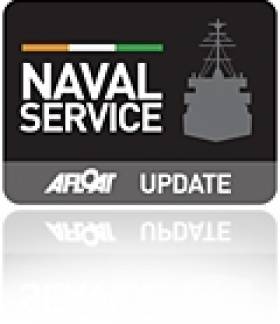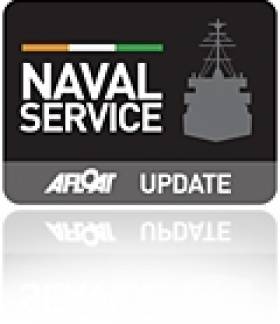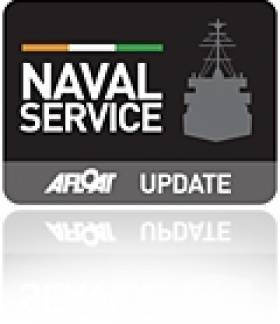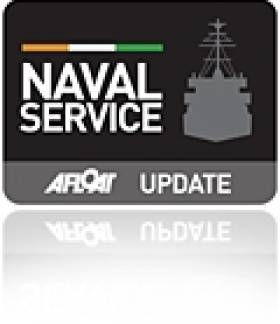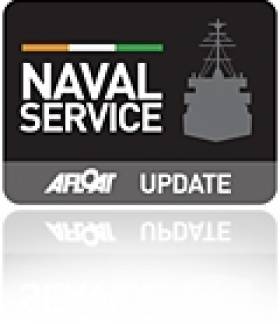Displaying items by tag: naval service
#SamuelBeckett - The state's newest naval vessel, the €50m LÉ Samuel Beckett (P61), is to be twinned with Cork City, homeport of the Irish Naval Service, reports The Irish Examiner.
A Naval Service spokesman confirmed the vessel, which boasts Star Wars-style 'drone' technology, as previously reported on Afloat.ie, will sail from the naval base in Haulbowline up to the city quays for the formal twinning ceremonies.
Final arrangements are still being put in place — the twinning ceremony will likely take place on June 7, with plans to open the ship for public tours on June 8. For more on this, click here.
As previously reported on Afloat.ie last year, there was speculation surrounding the newbuild OPV's twinning with Cork City and the confirmation aptly follows that of her predecessor, the former L.E. Emer whose adopted 'homeport' was also of the rebel city.
Asides the Naval Service historic use of drones or "unmanned aerial surveillance vehicles", the 'Beckett' class will also feature state-of-the-art technology among them robotic submersibles.
Call For Grounding Naval Service Over Asbestos Concerns
#Navy - The Irish Examiner reports on a solicitor's call for all Irish Naval Service vessels to be immediately docked and checked for asbestos.
Ernest Cantillon represents 10 people who believe they have been exposed to the hazardous substance, after it emerged recently that as many as 150 workers could be at risk after working on the LÉ Ciara and other vessels at naval headquarters at Haulbowline in Cork Harbour.
Asbestos dust was discovered during routine maintenance on the Naval Service patrol vessel in March, despite an audit of all ships a decade ago that declared them free of the formerly common insulation material.
It's now thought that up to 100 navy personnel and some 50 civilian workers may have been exposed - with no chance of compensation following a Supreme Court ruling in 20013 that only those diagnosed with asbestosis - which can take up to 40 years to develop - can sue the State.
The Irish Examiner has more on the story HERE.
#SamuelBeckett – As the sleek profile of Naval Service newbuild OPV L.E. Samuel Beckett (P61) got underway yesterday on the horizon off Killiney Bay (see photo at bottom this link) this was her first patrol since Saturday's joint naming and commissioning ceremony in Dublin, writes Jehan Ashmore.
At almost 90m long the Babcock Marine built OPV90 class L.E. Samuel Beckett is 12 metres longer than her predecessor the OPV80 class leadship 'Roisin'. She was followed by sister, L.E. Niamh in 2001, having also been built at the north Devon shipyard then managed by Appledore Shipbuilders.
The hull forms of the Beckett class and her sister L.E. James Joyce currently under construction are designed by STX Marine. The improved sea-keeping qualities of the hull (see link to Air Corps footage off Ballycotton and Dublin Bay) are not only to improve operational working conditions.
The increased length and aft-deck space provides for storage of containers for (potential UN mandated) missions requiring humanitarian supplies and equipment. As such the newbuild can carry more than the 'Roisin' class sisters. Another benefit of the longer hull is that of crew comfort, particularly during the harsh environment of the Atlantic.
Having left an overcast Dublin Bay and in considerably calmer seas she increased speed passsing Dalkey Island and as seen on the photograph on the horizon off Killiney Bay. This resulted in greater resistance as the bow wave increased at the flared bow designed to deflect water away and minimise impact on the hull while maximising speed and fuel efficiency.
She can achieve a maimum of 23 Knots which is generated from a pair of Wartsila diesel engines (10,000kw) which drive through twin shafts and propellers.
The newbuild has an endurance range of 6,000 nautical miles which will be required given that Ireland has a Fishey Exclusive Protection zone to patrol in an area representing 16% of EU waters. The OPV's main armament is a 76mm OTO Melara compact gun mounted at the bow.
As for that yellow buoy... in the photo, this is one of three marking a safety zone for bathers along a stretch of Killiney Beach close to Dalkey's White Rock Beach. They are there to protect bathers under a beach by-law implemented several years ago by Dun Laoghaire-Rathdown County Council.
Boating activity among marine leisure users, notably jet-skiers, are not permitted to transit the zone between the buoys and the beach in the interest of safety for swimmers.
#SamuelBeckett- A niece of Samuel Beckett, Caroline Murphy performed the honour of naming the Naval Service's newest OPV, L.É. Samuel Beckett (P61) and at her side An Taoiseach and Minister for Defence Enda Kenny witnessed the customary champagne bottle smash against the bow, writes Jehan Ashmore.
In his address, An Taoiseach said "the naming and commissioning carried with it a great sense of pride and anticipation for all Naval Service personnel. L.E. Samuel Beckett will be a tremendous asset to the Naval Service. I know that the ship's first captain, Commander Ken Minehane and his crew are eagerly looking forward to working up the new ship to its full potential".
The €50m L.E. Samuel Beckett named after the Nobel Prize winning playright, took place along Sir John Rogerson's Quay. Also on the quayside is the statue of the founding father of the Argentine Navy, Admiral William Brown who hailed from Foxford, Co. Mayo. Ahead of the L.E. Samuel Beckett's bow is the Liffey bridge that also bears the same name of the playright.
The appropriate backdrop to the historic occasion included the commissioning of the OPV90 class newbuild into the Naval Service which took place in front of an invited audience as well as the public during glorious conditions.
Among the Government representives was the newly appointed Minister for Justice and officials from shipbuilders, Babcock Marine & Technology, Appledore in north Devon, which floated out the newbuild last November and saw her completed last month as yard no. 194.
The vessel which docked yesterday (see photos), was blessed and following this the L.E. Samuel Beckett's captain, Commander Ken Minehan read out the commissioning warrant to the ship's coy. Then the captain was 'piped' on board the vessel that was officially accepted as a state ship.
L.E. Samuel Beckett – the view from one bridge to another!
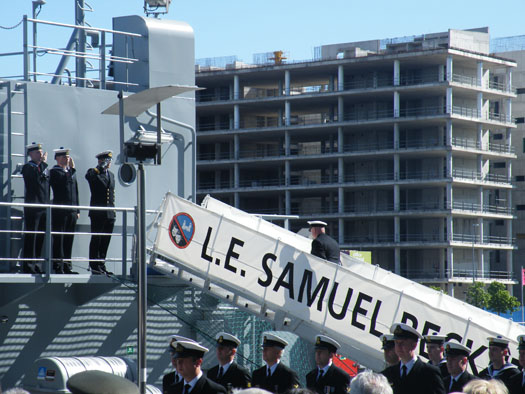
Captain Ken Minehan is 'piped' on board
The gangway also saw the ships company (off 44 personnel and 10 more for trainees) embark on the newest member of the Naval Service which has restored an eight-strong fleet follwing the decommissioning of L.E. Emer last year.
A sister of the newbuild, L.E. James Joyce (P62) which is constructed of 55 modular sections before been assembled is due to enter service next year. Together the 'Beckett' class cost €108m and among their primary roles are fishery protection, SAR, drug interdiction and monitoring of pollution incidents. Her main armement is the bow-mounted 76mm OTO Melara gun.
On board L.E. Samuel Beckett is an iconic photograph of the ship's namesake taken at Le Petit Café, Paris, in December 1985. This was Beckett's favourite place to meet his friends. The photographer, John Minihan was also on board to discuss the famous photograph with An Taoiseach, Captain Minehan and Caroline Murphy.
The other branches of the Defence Forces attended the ceremony, the Irish Army and Air Corps which provided a fly-past that tracked above the Liffey quays and involved a CASA Maritime Fisheries Patrol aircraft.
As guests explored the new vessel, the Army No. 1 Band played Adele's soundtrack to the James Bond film 'Skyfall' which all added to the celebratory atmosphere. Tomorrow (Sunday) afternoon, the newbuild will be open to the public between 2 and 5pm.
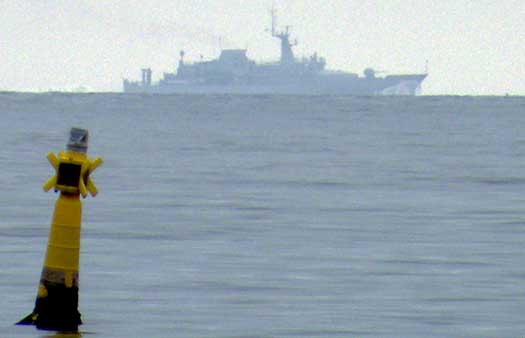
L.E. Samuel Beckett on first patrol after naming ceremony and is seen here off Killiney Bay
Irish Naval Ship LÉ Samuel Beckett Arrives on the Liffey
#samuelbeckett – The newest Naval Service ship L.É. Samuel Beckett (P61), the first of a pair OPV90 offshore patrol class newbuilds, docked in Dublin Port for the first time this morning and aptly close to her namesake bridge, writes Jehan Ashmore.
She sailed from the Naval Service Base on Haulbowline, Cork Harbour under captain and commander Ken Minehane and a crew of 55. Tomorrow morning, the OPV90 class newbuild costing €50m will be named and commissioned into service during a ceremony held at Sir John Rogerson’s Quay.
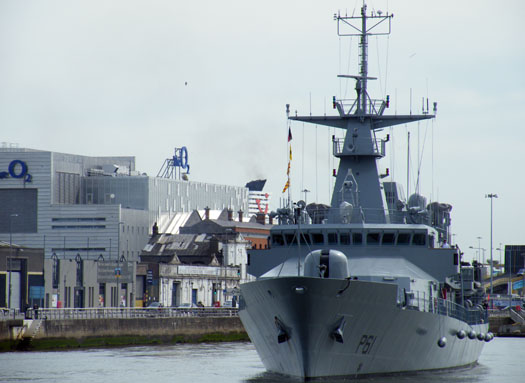
L.E.Samuel Beckett makes her Liffey debut Photo: Jehan Ashmore
An Taoiseach and Minister for Defence, Mr. Enda Kenny, T.D., will host the naming and commissioning ceremonies for the newbuild which will be named by Ms. Caroline Murphy, niece of Mr. Samuel Beckett. As previously reported the vessel will be open to public tours (2-5pm) tomorrow and also the same times on the Sunday.
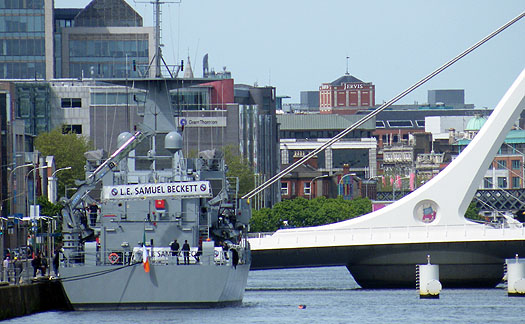
L.E. Samuel Beckett and the bridge also bearing her name. Photo: Jehan Ashmore
The newbuild is one of a pair ordered from Babcock Marine's north Devon shipyard, where L.E. James Joyce (P62) is under construction. She is expected to be completed and delivered in 2015. The sisters represent a €100m plus investment to upgrade an ageing fleet. The entry of this latest new tonnage is a direct replacement for L.E. Emer, which was sold last year to Nigerian interests.
L.É. Samuel Beckett’s Commissioning Ceremony to Take Place Close to Iconic Namesake Bridge
#LESamuelBeckett- The newest Naval Service OPV, L.É. Samuel Beckett (P61), the first of a pair of OPV90 class newbuilds, is to be commissioned into service at a ceremony held close to Dublin city's Samuel Beckett swing-bridge on Saturday, writes Jehan Ashmore.
It is fitting that the newbuild which cost €49m is to be commissioned close to the Dublin's most modern bridge that spans the Liffey since its installation in 2009.
Likewise of the navy's namesake newbuild, the swing-bridge arrived to the capital by sea!... having been constructed in the Netherlands was towed on a barge-pontoon and 'floated-in' (see photo) to Dublin Port.
If you are to compare the length of the bridge's span and that of the newbuild OPV, the bridge which was inspired by Santiago Calatrava is 123 metres long while that of the newbuild OPV90 class refers to her 90 metre length.
Public Tours
After completion of official proceedings on the Saturday morning, L.E Samuel Beckett will according to a Naval Service spokesperson speaking to Afloat.ie, be made available for her first public tour.
The inaugural tour is between 2-5pm on Saturday afternoon and repeated during the same hours the next day.
The 'Beckett' class newbuild was 'floated out' from Babcock Marine shipyard in north Devon last November made her delivery voyage to the Naval Base on Haulbolwine last month. She is of a design based from her predecessor the 'Roisin' class and that of STX Marine, Canada.
Notably, she is more than 10m longer in length and has an increased crew compliment of 55, compared to the 44 crew each of older half-sisters, L.E. Roisin and L.E. Niamh.
L.E. Samuel Beckett follows in the wake of L.E. Emer (P21), the veteran OPV that she directly replaced and which berthed opposite the Convention Centre on her final farewell visit to the capital on the occasion of Flightfest. She also made a special cruise in Dublin Bay for former crew members.
The former naval vessel sold to Nigerian interests and she still remains at Cork Dockyard, at a berth outside the dry-dock facility.
#EmergencyExercise- Around 180 personnel from nine different agencies between them worked together at Waterford Airport and off the coast of Hook Head, to assess how well they would respond to a major disaster.
According to Declan Geoghegan, operations manager with the Irish Coast Guard, the "nightmare" scenario would be a stricken passenger ferry with about 1,000 people on board and 100 miles offshore.
For yesterday's simulation, the Naval Service's flagship LE Eithne (P31) was a 'ferry' that had sustained an explosion in its engine room, with 50 army personnel from James Stephens Barracks in Kilkenny acting as casualties. To read more on the exercise, the Irish Examiner has a report.
#FisheryDetention – The day after the Naval Service's newest OPV90 class L.E. Samuel Beckett arrived at Haulbowline, the navy's second oldest unit, the 2001 built L.É. Niamh detained a Spanish registered fishing vessel, writes Jehan Ashmore.
L.É. Niamh carried out the detention 100 nautical miles south of Union Hall, the detention was in regards of an alleged breach of fishing regulations. The OPV80 class sister, the leadship L.E. Roisin also detained a Spanish fishing vessel almost a fortnight ago.
The newbuilds likewise of their pair of OPV 80 predecessors, the leadship 'Roisin' class are based from this design and that by STX Canada. However, the north Devon shipyard that built the Roisin sisters were then completed by Appledore Shipbuilders and which would later go into administration and where Babcock Marine took over in 2003.
According to the Naval Service, today's detained fishing vessel was escorted by L.É Niamh to Castletownbere, Co Cork and handed over to An Gardaí Síochána.
In total this year there were 169 vessels boarded by the Naval Service, 17 warnings issued and this latest detention is the fourth fishing vessel detained so far this year.
#LEsamuelBeckett – L.E. Samuel Beckett (P61) the first of a pair of OPV 90m class newbuilds, each costing €49m, arrived into Cork Harbour this morning, marking a momentous chapter in the history of the Irish Naval Service, writes Jehan Ashmore.
The 90m vessel of almost 2,000 tonnes sailed overnight from Babcock Marine's Appledore shipyard in north Devon, a distance of approximately 145 nautical miles.
However that distance actually refers to her first sight of the Irish coast off Ballycotton, where the east-Cork coastal community last weekend welcomed their very own with the return of the former lifeboat, the RNLB Mary Stanford of Daunt Lightship rescue fame.
L.E. Samuel Beckett, an enhanced 'Roisin' class OPV 80m offshore patrol vessel then made the short coastal passage to round Roches Point Lighthouse, prior to completing her delivery voyage within the natural harbour.
She docked at the Naval Base on Haulbowline, at the foot of the naval headquarters control tower that overlooks the island which has a basin. The basin is not constrained to tides as it has no lock gate, can berth the fleet that has now been restored to the original eight-strong fleet.
Beforehand, the fleet which was one short following the decommissioning of L.E. Emer (P20) last September that took place in Cork city-centre quays marking the end of an era and also the future with her direct replacement.
The newbuild was built on the banks of the River Torridge, where her keel was laid down in May 2012 and two years later L.E. Samuel Beckett is to named at a ceremony on 17 May along Dublin's city-centre quays, close to the Samuel Beckett swing-bridge.
The same building hall at Bidna downriver of Bideford also built L.E. Roisin (P51) in 1999 and L.E. Niamh (P52) in 2001 respectively. Then the yard which was founded in 1855 was owned by Appledore Shipbuilders until it went into administration in 2003.
International global engineering group, Babcock through its marine division brought the yard, and is one of only a handful of facilities remaining in the UK that is capable of building naval ships.
L.E. Samuel Beckett is to have a crew of 54 and she is replacement of L.E. Emer, the oldest unit of the naval fleet, which was built in 1978 at Verolme Cork Dockyard (VCD).
The 'Emer' still remains at the same yard in Rushbrooke, though current owners Cork Drydock carry out repair and maintenance work.
Work on the vessel has taken place to adapt her for a new role as the former leadship 'Emer' class vessel was sold last year to Nigerian shipping interests Uniglobe.
L.E. Samuel Beckett On Way after Builders Sea-Trails
#LEsamuelBeckett – Yesterday The Irish Times reported that the Irish Naval Service new €50 million offshore patrol vessel, LE Samuel Beckett (P61) is to sail in to Cork Harbour this morning (Wednesday 30 April) and welcomed to join the fleet at the Haulbowline Naval Base.
The ship, built by Babcock Marine at Appledore in Devon, has been undergoing sea trials for the past few months but last night the Naval Service took ownership of the vessel and its captain, Lt Cmdr Ken Minihane and his crew of 45, headed for Cork.
The ship will spend about a week at Haulbowline being fitted out with a number of armaments before sailing for Dublin, where a special commissioning ceremony is due to take place beside the Samuel Beckett Bridge on May 17th. Click for more on this story.


























